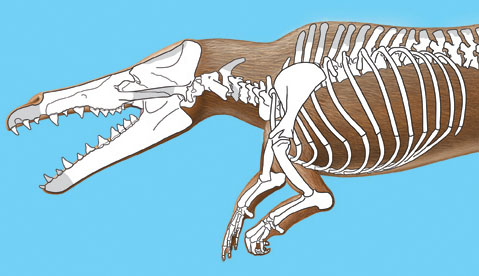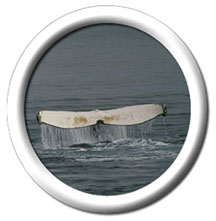Click on image for full size
Courtesy of John Klausmeyer and Bonnie Miljour, University of Michigan
Early Whales Gave Birth on Land
News story originally written on February 3, 2009
Two newly described fossil whales--a pregnant female and a male of the same species--reveal how primitive whales gave birth and provide new insights into how whales made the transition from land to sea.
The 47.5 million-year-old fossils, discovered in Pakistan in 2000 and 2004, are described in a paper published Feb. 4, 2009, in the online journal PLoS.
"This stunning discovery reinforces the belief that modern cetaceans originated from terrestrial ancestors," said H. Richard Lane, program director in the National Science Foundation (NSF)'s Division of Earth Sciences, which funded the research.
Paleontologist Philip Gingerich of the University of Michigan, who led the team that made the discoveries, was at first perplexed by adult female and fetal bones found together.
"When we first saw the small teeth, we thought we were dealing with a small adult whale, but then we continued to expose the specimen and found ribs that seemed too large to go with those teeth," Gingerich said. "By the end of the day, we realized we had found a female whale with a fetus."
It is the first discovery of a fetal skeleton of an extinct whale in the group known as Archaeoceti, and the find represents a new species dubbed Maiacetus inuus. (Maiacetus means "mother whale," and Inuus was a Roman fertility god.)
The fetus is positioned for headfirst delivery, like land mammals but unlike modern whales, indicating that these whales still gave birth on land.
Another clue to the whales' lifestyle is the well-developed set of teeth in the fetus, suggesting that Maiacetus newborns were equipped to fend for themselves, rather than being helpless in early life.
The 8.5-foot-long male specimen, collected four years later from the same fossil beds, shares characteristic anatomical features with the female of the species, but its virtually complete skeleton is 12 percent larger overall, and its canine teeth 20 percent larger.
Such size discrepancies are not uncommon among whales and their kin; in some species the females are larger, while in others the males are slightly to considerably bigger. The size difference of male and female Maiacetus is only moderate, hinting that the males didn't control territories or command harems of females.
The whales' big teeth, well-suited for catching and eating fish, suggest the animals made their living in the sea, probably coming onto land only to rest, mate and give birth, said Gingerich.
Like other primitive archaeocetes, Maiacetus had four legs modified for foot-powered swimming, and although these whales could support their weight on their flipper-like limbs, they probably couldn't travel far on land.
"They clearly were tied to the shore," Gingerich said. "They were living at the land-sea interface and going back and forth."
Compared with previous fossil whale finds, Maiacetus occupies an intermediate position on the evolutionary path that whales traversed as they made the transition from full-time land dwellers to dedicated denizens of the deep.
As such, it offers invaluable, new information on structural and behavioral changes that accompanied that transition, scientists say.
"Specimens this complete are virtual 'Rosetta stones'," Gingerich said, "providing insight into the life history of extinct animals that cannot be gained any other way."
Gingerich's co-authors on the PLoS paper are Munir ul-Haq of the Geological Survey of Pakistan; Wighart von Koenigswald of the University of Bonn in Germany; and William Sanders, B. Holly Smith and Iyad Zalmout of the University of Michigan.
The researchers also received funding from the Geological Survey of Pakistan, National Geographic Society and Alexander von Humboldt Foundation.
Text above is courtesy of the National Science Foundation








